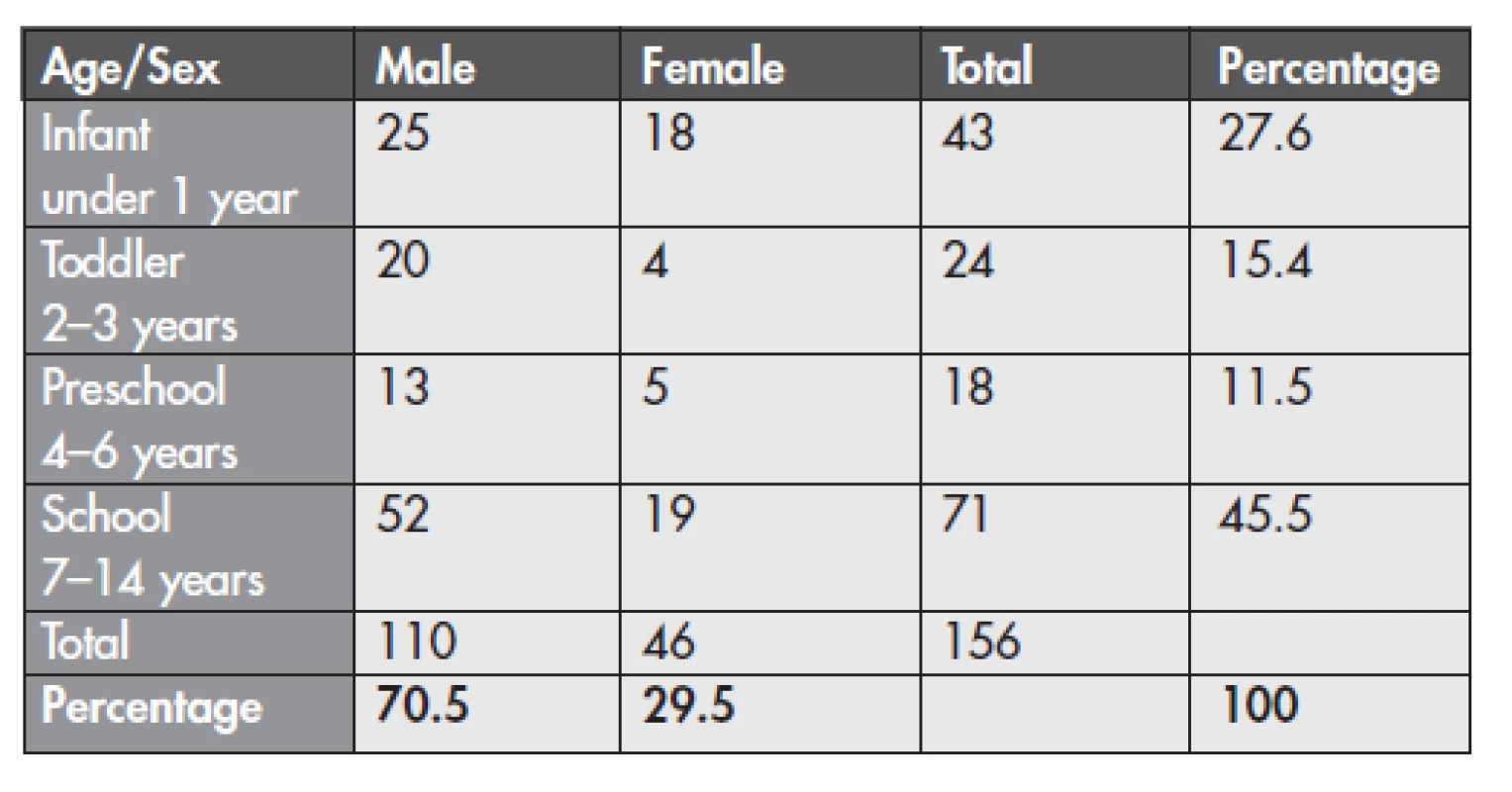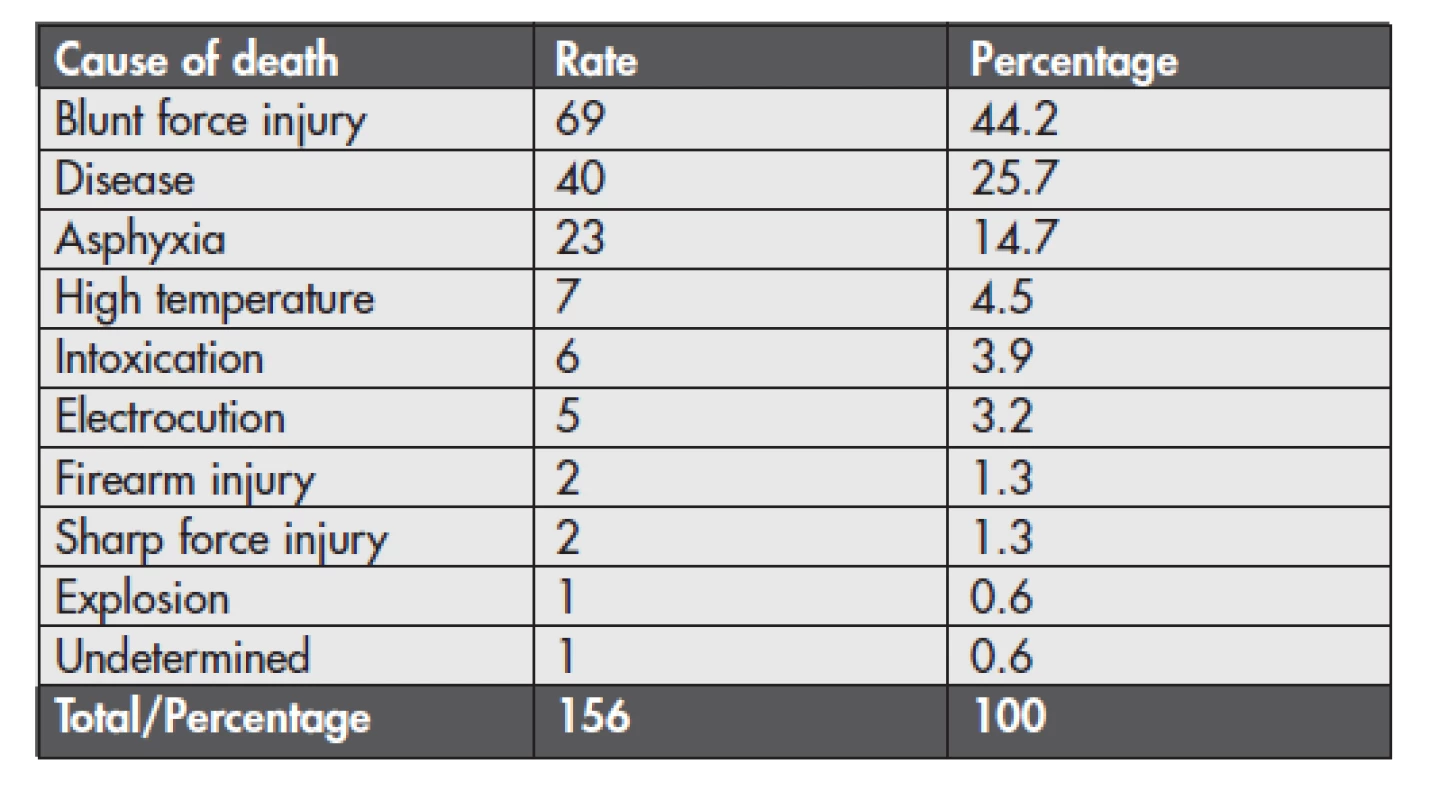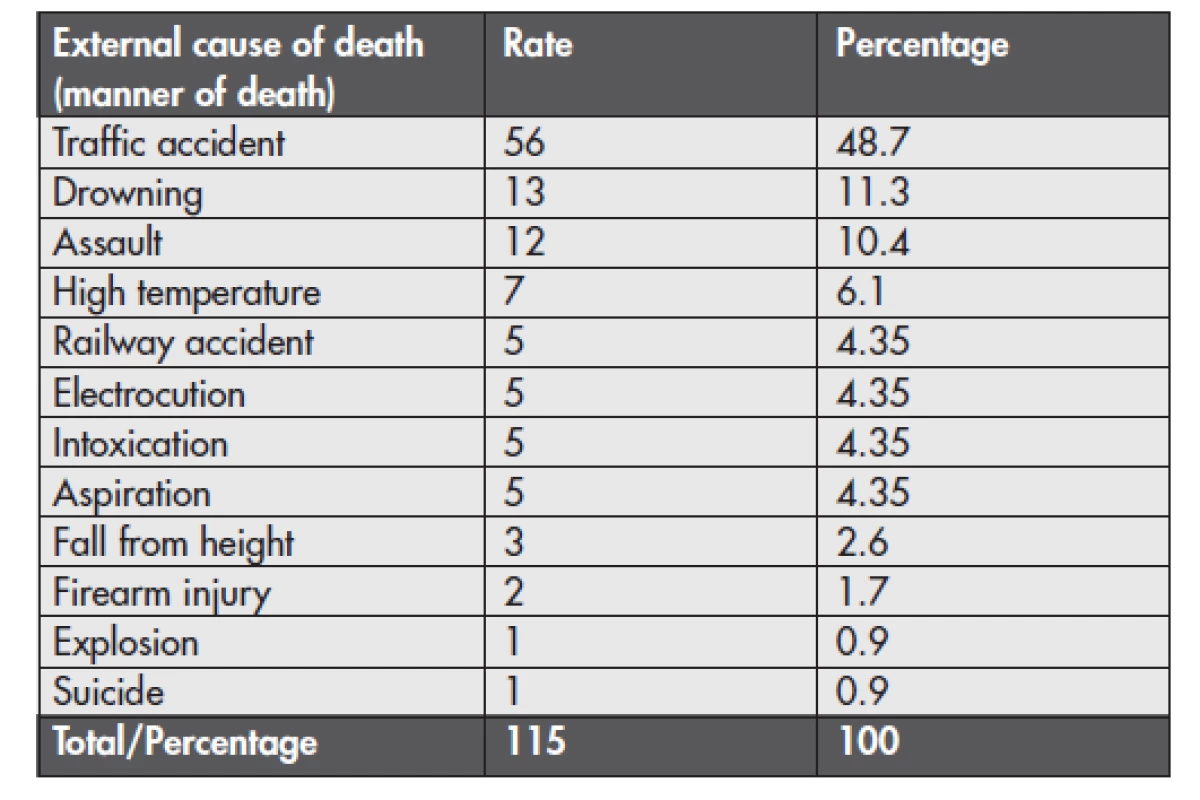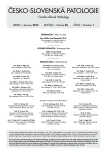Evaluation of childhood medicolegal autopsies in Bratislava and Trnava regions, Slovakia
Vyhodnotenie prípadov súdnolekárskych pitiev detí v Bratislavskom a Trnavskom kraji, Slovensko
Úvod:
Štúdie zaoberajúce sa analýzou prípadov násilných, náhlych a neočakávaných úmrtí v detskom veku sú veľmi dôležité, nakoľko tieto úmrtia môžu byť vo veľkom percente preventabilné. Cieľom štúdie bolo vyhodnotiť výsledky analýzy prípadov úmrtí v detskom veku pitvaných na bratislavských súdnolekárskych pracoviskách zo spádového územia Bratislavského a Trnavského kraja.
Pacienti a metódy:
Bola vykonaná retrospektívna analýza pitevných protokolov prípadov úmrtí v detskom veku (od 0 do 14 rokov) Ústavu súdneho lekárstva LF UK a Súdnolekárskeho pracoviska ÚDZS v Bratislave za obdobie rokov 1999 až 2008.
Výsledky:
V sledovanom období bolo zistených 156 úmrtí v detskom veku z celkového počtu 10 771 pitvaných prípadov, čo predstavuje 1,45 %. Násilné úmrtia boli zistené v 115 prípadoch t.j. 73,7 %. Prevládali deti mužského pohlavia v 70,5 % prípadov. Najčastejšou príčinou smrti boli poranenia spôsobené tupým predmetom v 44,2 % prípadov, nasledovali úmrtia z chorobných príčin (25,7 %), asfyxia (14,7 %), účinok vysokej teploty, intoxikácie, pôsobenie elektrického prúdu atď. Vonkajšou príčinou smrti boli najčastejšie dopravné nehody v 56 prípadoch (35,9 %), utopenie v 8,3 % (13 prípadov) a vraždy a napadnutia inou osobou v 12 prípadoch t.j. 7,7 %. V školskom veku bolo 45,5 % analyzovaných prípadov.
Záver:
Výsledky analýzy ukazujú, že Bratislavský a Trnavský kraj patria medzi regióny s pomerne nízkym výskytom násilných úmrtí v detskom veku. Štúdia ukázala, že mnohým úmrtiam bolo možné predísť lepšou starostlivosťou a väčšou zodpovednosťou predovšetkým rodičov ale aj iných osôb, ktoré sú zodpovedné za opateru a dozor nad deťmi.
Kľúčové slová:
detský vek – pitva – násilná smrť – náhla smrť – neočakávaná smrť
Authors:
J. Šidlo 1; J. Šikuta 1; R. Kuruc 1; H. Šidlová 2
Authors place of work:
Institute of Forensic Medicine, School of Medicine, Comenius University and Health Care Surveillance Authority, Bratislava, Slovakia
1; Institute of Pathology, Slovak Medical University and Cytopathos, s. r. o., Bratislava, Slovakia
2
Published in the journal:
Soud Lék., 57, 2012, No. 1, p. 13-16
Category:
Původní práce
Summary
Introduction:
Studies dealing with analysing cases of violent, sudden and unexpected deaths in childhood are very important, as these deaths can be prevented to a high percentage. The aim of this study is to evaluate the results of analysis of cases involving childhood deaths undergoing autopsy at Bratislava medico-legal workplaces within the catchment area of Bratislava and Trnava regions.
Patients and methods:
There was performed a retrospective analysis of autopsy protocols of death cases in childhood (from 0 to 14 years) at the Institute of Forensic Medicine of the School of Medicine Comenius University and Department of Forensic Medicine of Health Care Surveillance Authority in Bratislava in the period 1999–2008.
Results:
In the monitored period there were detected 156 childhood deaths from the total number of 10,771 autopsied cases, which accounts for 1.45 %. Violent deaths were determined in 115 cases, i.e. 73.7 %. In 70.5 % of cases there were male children. The most frequent cause of death were injuries caused by a blunt object in 44.2 % of cases, followed by deaths caused by pathological causes (25.7 %), asphyxia (14.7 %), high temperature, intoxication, electrocution, etc. The external cause of death was most frequently traffic accidents in 56 cases (35.9 %), drowning in 13 cases (8.3 %) and homicides together with assaults in 12 cases (7.7 %). There were 45.5 % of the analysed cases in school age.
Conclusion:
The results of our analysis show that Bratislava and Trnava regions fall into regions with relatively low incidence of violent deaths in childhood. Our study has shown that many deaths could have been prevented by better care and higher responsibility of parents in particular, but also those who are responsible for the care and supervision of children.
Keywords:
childhood – autopsy – violent death – sudden death – unexpected death
The arrangement of studies on the causes of childhood deaths and recording the findings are very important (1). Suspicious and unnatural deaths are evaluated as medico-legal death cases. The medico-legal autopsy process performed by forensic experts is an operation that demonstrates the physical evidence and causes of deaths, in order to prevent problems which may arise in the future, who die as a result of accidents, suicides, homicides or who die alone and unexpectedly (2).
The United Nations Convention of Children’s Rights states that the child has the right to the highest attainable level of health and the right to a safe environment (3). It must be focused not only on the fundamental children’s rights agreement, but also on children’s education and development rights. In this context, it is very important to record the data about the childhood death causes (1).
Establishment of death mechanisms, recording and reporting of the obligation of all death causes in childhood will contribute to uncovering the death causes (4). Moreover, mortality in infancy and childhood serves as a good indicator of the population well-being. Injury is the most common cause of death among children in Europe and is a major public health problem worldwide (5). In spite of the fact that Europe enjoys the lowest average rates of childhood mortality in the world the rates vary considerably between European countries. Deaths from external causes account for an important fraction of the gap in overall childhood mortality between Eastern and Western Europe (6,7).
The most important characteristic of child injury deaths is the fact that many, if not all, can be prevented (8,9,10). Therefore, detailed information on the occurrence and circumstances surrounding particular types of injury needs to be collected and analysed, if effective interventions are to be developed (7). Some authors have found that 2.7 % of natural deaths and 96 % of injury deaths are preventable (11).
The aim of this study is to evaluate the results of analysis of the cases of violent, sudden and unexpected deaths in childhood undergoing autopsy at Bratislava medico-legal workplaces within the catchment area of Bratislava and Trnava regions.
Patients and methods
There was performed a retrospective analysis of autopsy protocols of death cases in childhood in the current Bratislava and Trnava regions during a 10-year period from 1999 to 2008. For categorization of childhood age there were used the following common criteria: infant age (0–1 year), toddler age (2–3 years), preschool age (4–6 years), school age (7–14 years) published by Šašinka, Šagát et al. (12). In all cases the autopsy was performed via a standard method completed with histopathological examinations and due to the nature of the case also with toxicologico-chemical laboratory examinations. Autopsies were performed at the Institute of Forensic Medicine of School of Medicine Comenius University (SM CU) in Bratislava in the period from 1999 to August 2007 and at the current Department of Forensic Medicine of Health Care Surveillance Authority (HCSA) in Bratislava from 1999 to 2008. (Since September 2007 all medico-legal autopsies within the catchment area of both regions have been performed only at the Department of Forensic Medicine of HCSA – author’s note). In the monitored period there lived about 1,184 thousand inhabitants in the catchment area, which accounts for more than one fifth of the population of the Slovak Republic. In all selected cases there were evaluated autopsy protocols including the results of additional laboratory examinations, all police records and health documentation available.
RESULTS
In the monitored period from 1999 to 2008 there were performed totally 10,771 autopsies within the catchment area of Bratislava and Trnava regions at the Institute of Forensic Medicine SM CU and at the current Department of Forensic Medicine of HCSA in Bratislava.
From the total number of autopsied cases there were determined 156 death cases in childhood, which accounts for 1.45 %. In this group there were male children – 110 cases (70.5 %), female children represented 29.5 % (46 cases). Most cases – 71, accounting for 45.5 % of all cases, were detected in the age category ranging from 7 to 14 years, i.e. school age, followed by infant age, toddler age and preschool age. Distribution of cases according to gender and age is shown in Table 1.

The incidence of cases in particular years varied between 10 (6.4 %) in 2002 and 2003 and 22 (14.1 %) in 2001 and 2004. Figure 1 shows the case rates in particular years.

Categorization of cases according to the cause of death indicated that almost 73.7 % (115 cases) were violent deaths. Pathological causes (sudden and unexpected deaths) represented 25.7 % of deaths. One case (0.6 %) dealt with an undetermined cause of death. The most frequent cause of death was blunt force injuries (44.2 %), followed by deaths caused by pathological causes (25.7 %), asphyxia (14.7 %), high temperature, intoxication, electrocution, etc. Detailed distribution of cases according to the cause of death, rate and percentage is shown in Table 2.

The most frequent cause of death in the group of deaths caused by pathological causes was sudden infant death syndrome (SIDS) in 10 cases (25 %), followed by congenital defects in 9 cases (22.5 %), inflammations in 7 cases (17.5 %), sudden death other than SIDS in 6 cases (15 %), metabolic disorders in 3 cases (7.5 %), cerebral palsy in 2 cases (5 %) and tumor, pulmonary artery thrombo-embolism and other cause each one case, i.e. each (2.5 %).
The external cause of death was most frequently traffic accidents in 56 cases (35.9 %), drowning was determined in 13 cases (8.3 %) and assaults in 12 cases (7.7 %) from the total number of cases. In the group of violent deaths there were traffic accidents in almost 48.7 % of the cases, drowning in 11.3 % and assaults in 10.4 % of the cases. It was followed by high temperature, railway accidents, electrocution, intoxication, aspiration, falls from height, firearm injury, explosion and suicide. Distribution of cases according to the external cause of death is shown in Table 3.

In traffic accidents there were 25 cases (44.6 %) involving passengers, 24 cases (42.9 %) involving pedestrians and 7 cases (12.5 %) involving cyclists.
In assault cases there were 7 cases (58.3 %) of homicide, from which 2 cases (28.5 %) by sharp force and the remaining 5 cases (14.3 %) involved fall from height, strangulation, suffocation, blunt violence and firearm injury. In other cases (41.7 %) there occurred the assault by blunt force in 4 cases (80 %) and once administration of a foreign substance (20 %). Nine cases (5.8 %) from the total number corresponded to the definition of a syndrome of child abuse and neglect.
In the group of intoxications there were 3 cases (50 %) of Death Angel poisoning, 1 case of drug intoxication, 1 case of carbon monoxide poisoning and 1 case of methadone overdose, representing together other 50 %.
There was recorded one case of suicide of a 13-year-old boy by a firearm injury accompanied by the good-bye letter found at the scene.
DISCUSSION
Deaths in childhood present various features with respect to age, sex, developmental stage, social and cultural context, geographical location and life styles of the family (13,14). According to Canturk et al. (15) childhood injuries and the related deaths are the most important issues of forensic medicine. Investigation of childhood autopsies is important especially for determining the causes and prevention of childhood injuries and deaths. Accidents and natural deaths are the common causes of death in children as well as in adults (14,16).
In this study, childhood medico-legal autopsies according to the causes and manners of death were evaluated. The records of the autopsies performed in the Institute of Forensic Medicine SM CU and the current Department of Forensic Medicine of HCSA in Bratislava between the years 1999 and 2008 were reviewed and 156 (1.45 %) of 10,771 deaths were found to be in childhood ranging from 0 to 14 years. From these cases of 0–14 age group, 110 (70.5 %) were male and 46 (29.5 %) were female.
Altogether, 115 of deaths in autopsied children (73.7 %) were attributed to the external causes. From the remaining 41 cases 40 were confirmed to be caused by diseases and in one case the cause of death was undetermined.
According to one of Turkish studies (17) child injuries and deaths are seen usually within the first five years of life. In our study there were determined 54.5% of the cases in the age group 0–6 years.
Thus, the average annual mortality from injuries in Bratislava and Trnava regions was 7.2 per 100,000 children in the age group 0–14 years. In the monitored period we recorded a decrease of mortality from injuries from 9.7 per 100,000 in 1999 to 5.0 per 100,000 in 2008. As mentioned above, in the monitored period there was the population of about 1.184 thousand in Bratislava and Trnava regions, from which about 160,000 (13.5 %) were children at the age of 0–14 years. It is possible to compare our results with for example the results of Estonian national study in the period 2001–2005, as the Estonian population was about 1.344 thousand. In Estonia in the above-mentioned period there were performed 262 medicolegal autopsies of 0–14-year-old children, 60 % of which were male and 40 % female. To the external causes of deaths there were attributed 81 % of the cases. The average annual mortality from injuries in Estonia was 19.1 per 100,000 (10).
Traffic accidents were the leading cause of death in 48.7 % of all deaths caused by injury with the average rate 3.5 per 100,000 children at the age from 0 to 14 years, similarly as in Estonia (22.3 %) with the rate 5.3 per 100,000. A spectrum of participants of traffic accidents varied. In our study the most affected were passengers (44.6 %), followed by pedestrians (42.9 %) and cyclists (12.5 %), whereas in the Estonian study the sequence was as follows: cyclists 44.7 %, passengers 40.4 % and pedestrians 14.9 % (10). In another Turkish study (1) traffic accidents were determined in 70 % of violent deaths.
As the second leading cause of unintentional injury death in children aged to 14 years is considered drowning (1,10,18,19), which was confirmed also by our analysis in 11.3 % of the cases.
Assaults took in our group the third place. There were 12 cases (10.4 %), from which 7 (58.3 %) were homicides. Homicides represented 6.1 % from the total number of violent deaths, which compared to Estonia (10) is 2.5 % less. The most homicides in childhood has been recorded in the United States. In a study performed in 1995 in 26 industrial countries of the world there were presented 2,872 violent deaths in childhood (0–14 years), from which 1,995 (69.5 %) were homicides. Of these homicides, 1,464 (73.4 %) occurred among U.S. children. The homicide rate for children in the United States was five times higher than that for children in the other 25 countries combined (2.57 per 100,000 compared with 0.51) (20). The rate of homicides in childhood in Bratislava and Trnava regions is even lower: 0.36 per 100,000.
The remaining 29.6 % of the cases of violent deaths ranged from 7 to 1 cases caused by high temperature, railway accidents, electrocution, intoxications, aspiration, fall from height, firearm injury, explosion and a case of suicide as mentioned in the results.
With respect to a immediate cause of death in our study in the group of violent deaths the leading causes of deaths was blunt force injuries in 44.2 % of all cases and in 60 % in the group of the external causes of deaths. Similar results were obtained also in other studies (1,21).
CONCLUSION
The results of our analysis show that Bratislava and Trnava regions fall into regions with relatively low incidence of violent deaths in childhood. However, it is not the matter for underestimating this issue. For the purpose of establishing correct diagnosis of a proximate and also external cause of death together with evaluating the whole case there should be investigated the crime scene, event format, and a detailed medical and family history. The autopsy should include the detailed external and internal examination and appropriate laboratory tests. But not only medical issues should be evaluated, but also the social aspects must be managed, while regional and broader social solutions need to be created.
On the basis of the results of our analysis of the group of cases it is possible to state that many deaths could have been prevented by better care and higher responsibility of parents, but also those who are responsible for the care and supervision of children.
ACKNOWLEDGEMENTS
Anna Cibulková, Institute of Foreign Languages, School of Medicine Comenius University Bratislava, Slovakia
Address for correspondence:
Jozef Šidlo, MD., PhD.
Institute of Forensic Medicine, School of Medicine,
Comenius University and Healthcare Surveillance Authority
Antolská 11, 857 01 Bratislava, Slovakia
tel: ++421259357264, ++421268672349, ++421904819241
fax: ++42120856556, e-mail: sidlo45@gmail.com
Zdroje
1. Beyaztas FY, Dokgöz H, Saka E, āitici I, Bütün C. Evaluation of childhood deaths in Istanbul, Turkey. Middle East J Family Med 2007; 5(2): 38–41.
2. Tokdemir M, Türkoglu A, Kafadar H, Düzer S. The evaluation of medicolegal autopsy events which was done in Elazig between 2001–2006. Bull Legal Med 2008; 13(1): 57–62.
3. United Nations. Convention on the Rights of the Child. New York. 1989.
4. Aksoy E, Inanici MA, āolak B, Polat O. Child Deaths. In :1st Congress of Forensic Sciences, April 12–15, 1994, Adana, 1995 : 233–235.
5. Crawley T. Childhood injury: significance and prevention strategies. J Pediatr Nurs 1996; 11(4): 225–232.
6. McKee M, Oreskovic S. Childhood injury: call for action. Croat Med J 2002; 43(4): 375–378.
7. Childhood injuries. A priority area for the transition countries of Central and Eastern Europe and the Newly Independent States. Final Report. ECOHOST, London School of Hygiene and Tropical Medicine in collaboration with WHO European Centre on Environment and Health. London; 1998.
8. Wheatley J, Cass DT. Traumatic deaths in children: the importance of prevention. Med J Aust 1989; 150 : 72–78.
9. Rivara FP. Prevention of injuries to children and adolescents. Inj Prev 2002; 8 : 5–8.
10. Väli M, Lang K, Soonets R, Talumäe M, Grjibovski AM. Childhood deaths from external causes in Estonia, 2001–2005. BMC Public Health 2007; 7 : 158. doi:10.1186/ /1471-2458-7-158
11. Saunders CO, Forjuoh SN, West P, et al. Child death reviews: a goldmine for injury prevention and control. Inj Prev 1999; 5 : 276–279.
12. Šašinka M, Šagát T, et al. Pediatria. I. Vol. Satus: Košice; 1998 : 45. (in Slovak)
13. Schmidt P, Müller R, Dettmeyer R, et al. Suicide in children, adolescents and young adults. Forensic Sci Int 2002; 127 : 161–167.
14. Skici M, Skici ET, Aksoy E, et al. Retrospective analysis of medicolegal autopsies in the 0–18 age group in Turkish republic of Northern Cyprus. In: 17th Congress of the International Academy of Legal Medicine, Dublin, 1997; 38.
15. Canturk N, Esciyok B, Ozkara E, Canturk G, Ozata AB, Yavuz FM. Medico-legal child deaths in Istanbul: data from the Morgue Department. Pediatr Int 2007; 49(1): 88–93.
16. Cooper A, Barlow B, Davidson L, et al. Epidemiology of pediatric trauma; Importance of population - Based Statistics. J of Ped Surgery 1992; 27(2): 149.
17. Butun C, Guven FMK, Dokgoz H, Eren SH, Korkmaz I, Beyaztas FY. Evaluation of childhood autopsies in Sivas, Turkey. Scientific Research and Essays 2010; 5(23): 3668–3671.
18. Centers for Disease Control and Prevention, National Center for Injury Prevention and Control. Web-based Injury Statistics Query and Reporting System (WISQARS) [online]. [cited 2011 Jul 4]. Available from: URL: http://www.cdc.gov/injury/wisqars
19. Borse NN, Gilchrist, J, Dellinger AM, Rudd RA, Ballesteros MF, Sleet DA. CDC Childhood Injury Report: Patterns of Unintentional Injuries among 0-19 Year Olds in the United States, 2000–2006. Atlanta (GA): Centers for Disease Control and Prevention, National Center for Injury Prevention and Control, 2008.
20. Krug EG, Dahlberg LL, Paell KE. Childhood homicide, suicide, and firearm deaths: an international comparison. World Health Stat Q, 49, 1996.
21. Cekin N, Hilal A, Gülmen MK, et al. Medicolegal childhood deaths in Adana, Turkey. Tohoku J Exp Med 2005; 206(1): 73–80.
Štítky
Patologie Soudní lékařství ToxikologieČlánek vyšel v časopise
Soudní lékařství

2012 Číslo 1
Nejčtenější v tomto čísle
- Immunohistochemistry and serum values of S-100B, glial fibrillary acidic protein, and hyperphosphorylated neurofilaments in brain injuries
- The importance of the detail forensic-neuropathological examination in the determination of the diffuse brain injuries
- Evaluation of childhood medicolegal autopsies in Bratislava and Trnava regions, Slovakia
- IV. Symposium Osteuropaverein Rechtsmedizin
